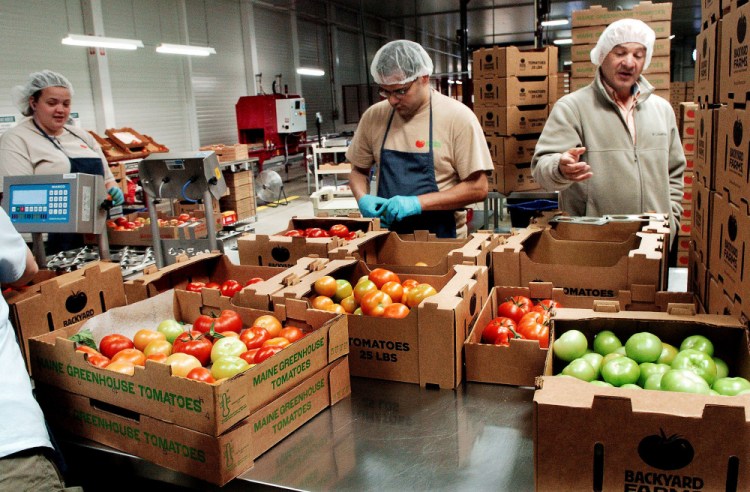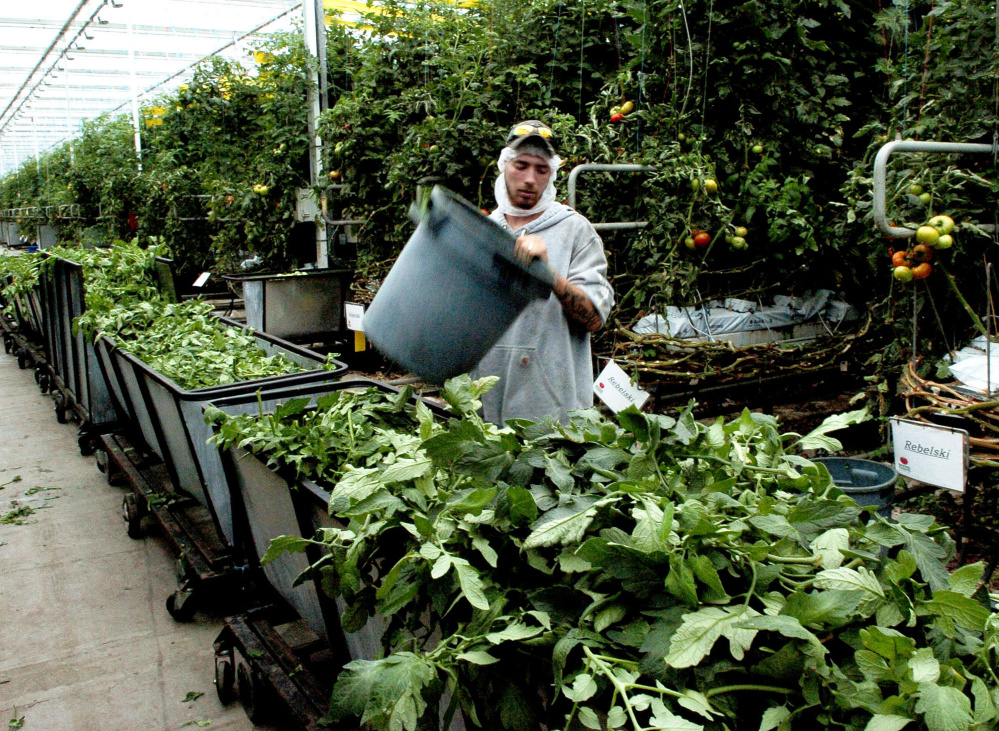MADISON — Sharon Chastain was busy sorting through cardboard crates of fresh tomatoes on a recent morning at Backyard Farms, carefully separating store-ready perfect red fruit from smaller, bruised or green tomatoes.
The less than perfect product was sent on a conveyor belt out of the area, ultimately destined for a waste compressor along with barrels full of leaves and stems trimmed from the roughly 600,000 plants at Backyard Farms, a commercial greenhouse producing 25 to 30 million pounds annually of beefsteak, cocktail and tomatoes on the vine.
“We’ve been looking for a solution that was more environmentally sustainable, and the town was looking for a way to grow their revenue stream,” said Stuart Jablon, president and chief operating officer of Backyard Farms, as he stood at the other end of the warehouse watching the compressor eat up barrels of plant waste that for now is headed to landfills. “Somehow we were able to cross paths.”
Backyard Farms, the largest employer in Madison, generates about 3,000 tons of waste annually. Since the greenhouse opened in 2006, waste has been compressed and then carted off to a landfill in Norridgewock.
But the amount of waste taken to the landfill will be drastically reduced if the company and local sanitary district follow through on a proposed partnership that would liquify and remove the water from the greenhouse plant waste, leaving only about 10 percent of the overall waste to become compost or be taken to the landfill. The sanitary district board of directors has already approved the move.
“We’re going to reduce volume by eliminating the water portion,” said Dale Clark, superintendent of the Anson-Madison Sanitary District. “Tomatoes are about 92 percent water, and right now all of that is going into the landfill.”
The partnership will also generate about $125,000 extra in revenue for the sanitary district each year, Clark said, a much needed source of additional revenue after the loss of their largest customer, Madison Paper Industries, in May.
The sanitary district processed waste water used in the paper-making process while the mill was open, generating about $3 million in revenue for the district each year.
“We’ve also reduced our operating costs since the mill closed, but in many ways it has been a huge impact,” Clark said.
Meanwhile, up the road Backyard Farms has been exploring for years alternatives to taking its plant waste to landfills, Jablon said.
The question of what to do with plant waste is a “huge problem throughout the world,” said Clark, who said that in general many commercial greenhouses generate tons of leaf and plant clippings that get sent to landfills.
That’s generally not a problem at smaller or outdoor farms where plant waste can be composted or easily spread on fields, said Mark King, an environmental specialist for the Department of Environmental Protection’s division of sustainability and the director of the Maine Compost School, a project of the University of Maine Cooperative Extension.
But at Backyard Farms, where plants are grown hydroponically — without soil — there is no use for compost on-site, and according to Jablon, on-site composting would also increase the risk of pests and disease.
“We see a lot of re-use in the smaller farms, but the larger ones tend to produce so much volume of this vegetable matter and a lot of them don’t have land or a compost facility associated with them, so it’s easier for them to just contract with a waste hauler,” King said.
At Backyard Farms, officials have explored more environmentally friendly solutions for handling waste in the past, but Madison’s rural, relatively remote location means that the cost of contracting with an outside composting firm does not make economic sense, according to Jablon.
“If you don’t have your own operation, contractors often want a set time for pick-up and they want enough volume to make it worthwhile financially,” King said. “They tend to store it and let it build up and sometimes other stuff can get thrown in there (that is not compostable).”
The 3,000 tons generated at Backyard Farms is mostly plant waste, although there may be a small amount of non-organic material that gets mixed in, according to Jablon.
It’s easy to see how much waste is produced as the tomatoes are grown, given that each week employees dutifully pull exactly three stems of leaves from each of the 600,000 plants. Pulling away excess leaves keeps the plant’s energy flowing into the fruit and keeps it exposed to sun and visible for harvesting, Jablon explained during a walk-through of one of two greenhouses at Backyard Farms.
Stems and leaves make up about 80 percent of the waste while tomatoes that are either not the right size or color or are damaged make up the other 20 percent, Clark said.
There is no contract in place yet between the two groups, but Clark said that if all goes well, the sanitary district could start taking Backyard Farms’ waste in September.
Jeff McGowan, senior district manager for Waste Management in Norridgewock, said the move will also be good for the Crossroads landfill, as it will free up space and also reduce the amount of leachate, water that has been contaminated by waste, that needs to be treated.
“Less water is good,” McGowan said. “Any time you have the opportunity to divert waste that could go elsewhere it definitely increases landfill capacity.”
The district also has to invest in about $50,000 to $100,000 worth of equipment before they can start processing the waste, Clark said.
Although the sanitary district has a contract with New England Compost, it’s immediate plans do not include converting plant waste into compost.
“At some point in time we will be exploring composting and possible anaerobic digestion to make methane gas,” Clark said. “Those are down the road a ways. For now we’re just focusing on reducing volume.”
Mike Aalto, a spokesman for Backyard Farms, did not have a specific number for how much cost savings the partnership will bring about for the company, but said that’s not the main reason behind it.
“We just feel this is a better option from an environmental perspective,” Aalto said. “To us that’s the real benefit.”
Rachel Ohm — 612-2368
Twitter: @rachel_ohm
Send questions/comments to the editors.





Comments are no longer available on this story